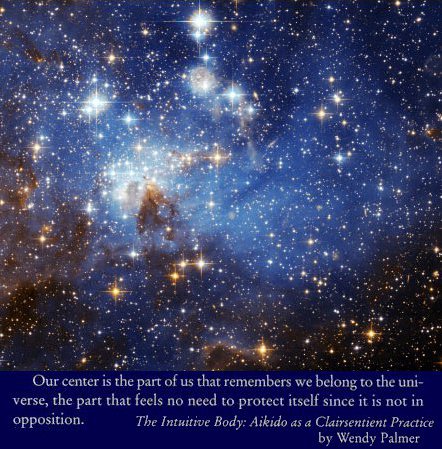Center
Living
without opposition
How do we find the center? What are the
landmarks? In her book The Intuitive Body: Aikido as
a Clairsentient Practice, Wendy Palmer provides a
'feeling-sense' of where the center is. It is that
part of you where you belong to the universe, that part of
you which is safe.
The third thing you will learn in your first lesson from me
is how to connect with yourself and your horse by finding your
center.
  
What's the benefit of this?
On a really practical level, this is what keeps you
on your horse!
Many times when I share that I ride the first thing
someone says is 'You must have really strong legs!'
(which, actually, I do, but it's not from riding...)
In Centered Riding you're given the tools to balance.
By balancing on the horse you now have a greater deal of
security than physical effort could give you.
Why? Gravity is stronger than muscle. The
planet is bigger.
One of my first riding instructors used to joke,
"Just keep the horse between you and the
ground." Yep. That sums it up. If
you keep the horse between you and the ground, gravity will
keep you on the horse. More specifically, if you keep
your center over the horse's center, the
two of you will go places together.
By being balanced, your musculature is free to do
beautiful things -- it's not trying (albeit misguidedly) to
keep you alive by gripping. So all the effort that
would've gone into gripping is now available to dance with
the horse -- to be subtle and receptive.
Because you're not gripping on the back of a prey
animal that's instinctively aware that things that will
kill it grip on its back, your horse is not freaking
out. Always a good thing. (How many
horses are speeding around in terror? Yes, there's a
point where they flood
and it's all better, but instinct is instinct after
all. Why would we want to invoke a fight-to-the-death
reflex? And then try to convince a being a lot bigger
than a person to ignore that?) Me, I'd rather be on
the calm horse than the
terrified horse.
Not only is the calm horse not trying to kill me, it,
too, has more energy for the
dance. The calmness allows it to be
present and pliable. That durchlassigkeit
stuff. Which I love. I love the durchlassigkeit
and the anlehnung. From these you get partnership.
When you are centered, you invite, through leadership,
for your horse to center. When you are both centered,
you are connected and
have your full resources available. This gives you
all the other stuff we want - self-carriage, loft,
tractability, relaxation. And because it's a
partnership, you take on and fulfill your responsibility
and the horse takes on and fulfills its responsibility.
If you are centered and your horse is working things
out, you are present and supportive (anlehnung!) so
that they can work things out. You get brownie points
for being an asset. You get ticky points in the 'good
thing' column. Life is Good!!! Even before your
horse gets things sorted out, and then when they do, Life
is even better!!!
(OK, does this happen in five minutes? It
can. If you've got a lifetime of doing something
else, it might not. This is where you learn to be 'in
process.' Which where we always ever are anyway;
however, when you learn how to be there, it becomes a lot
more pleasant! Because I'd rather not flail around
forever, and I'm such a klutz, I rely upon Centered Riding
(Tai Chi and Alexander) and also incorporate Feldenkrais
and Ortho-bionomy approaches. Because these are based
on how the brain works and changes and how the body works
and changes, they are quicker than the traditional recipes
for 'how to ride.' Another layer of facilitating
change can be pulled in with Reiki, Psych-K, Equine
Positional Release, and Resonance Repatterning. All
of these help to dissolve the not-so-helpful patterns from
the past so that new ways can slide in and secure
themselves more easily.)
Also, those of us in the Centered Riding world have
noticed we stay a bit healthier, when we get sick, we
recover a little bit faster, and the belly weight tends to
sit much better inside the pelvis. There are other
(positive) health changes we've noticed after incorporating
Centered Riding, too. Energetically, the hara has to
do with how we show up in the world, how we behave in
partnerships (aka marriage, work, kids), how we assert our
own needs, and how satisfied we are with life.
So being centered is a safety thing and also a
practical thing. And it's also an artistic
thing. And a life thing.
  
An Approach
There are a few previous articles I've done
-
When you combine the physical landmarks of where the
center might be with the idea of 'do I feel a sense of
connection and belonging in the universe?' you can imagine the
center in slightly different places until you get to
'Yes! I do feel a sense of connection and belonging in
the universe!'
At the other end of the spectrum, if you're having a fight
with your horse, that's probably a good indication you're
not centered. Having a fight is opposition, the
opposite of connection.
Of course, another option is some hands on guidance and
feedback! Interested? Call or email or pm and and set up a
lesson! This is what I teach. Let me share with
you how
to use these concepts for greater understanding and
harmony with your horse. The fabulous rides follow.
Lynn
Centered Riding Instructor & Level
III Clinician
|




![Centered Riding Today: An Informal Talk by Sally Swift [VHS]](http://ecx.images-amazon.com/images/I/41Vn6PfhzML._SL125_.jpg)
![Centered Riding with Sally Swift [VHS]](http://ecx.images-amazon.com/images/I/51OSh9kd9iL._SL125_.jpg)




